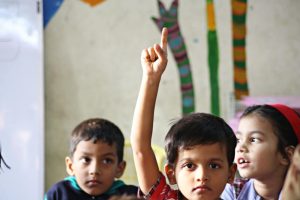
Being in touch with nature is particularly essential in this digital world. Human interaction these days has more to do with machines and devices rather than other living beings. Children are growing so far removed from nature in concrete jungles without even the meager interaction with nature that the previous generation enjoyed. They are stuck indoors glued to some screen or the other, communicating with virtual manifestations rather than real life plants and animals. Nature pedagogy offers a means of bridging this disconnect with nature starting from a child’s early years.
What is Nature Pedagogy?
 Nature pedagogy is just a fancy term used for an early education model that provides an immersive experience in nature during a child’s formative years. Its practitioners strongly believe that there is no better teacher than Mother Nature. Children learn everything they need to learn between the ages 2 to 5 through various interactions with nature.
Nature pedagogy is just a fancy term used for an early education model that provides an immersive experience in nature during a child’s formative years. Its practitioners strongly believe that there is no better teacher than Mother Nature. Children learn everything they need to learn between the ages 2 to 5 through various interactions with nature.
The concept came into existence way back in the 1950s in Sweden and Denmark and have been adopted by countries like the UK and the US since the 1990s. Today, there are several “forest schools” in Europe and North America that involve nature in every bit of their teaching philosophy. Not just in the setting of the educational space – indoors, outdoors, and the great beyond – children are kept in contact with Nature in every activity they do in the school. However, there are also nature schools that allocate only certain blocks of outdoor time every day for children to interact with nature.
Explore More About : Understanding Ecosystem Education & The Benefit Of It
In either case, measurable outcomes have proven that this teaching methodology is effective in children. It helps the children stay grounded and connected to nature in their day to day activity. Painting the indoors in nature themes, complete with fresh plants and bird song, provision of opportunities to commune with plants and animals on a daily basis, like growing plants or feeding animals, are just some of the ways these forest schools develop a deep respect and love for nature in children.
What About Nature Pedagogy in India?
This concept is yet to catch on in our country. But Montessori schools and other kindergarten schools do include basic interactions with nature in their teaching programs. They take children on field trips to the park, the vegetable market or engage them in small gardening projects for germinating seeds or gathering flowers.
basic interactions with nature in their teaching programs. They take children on field trips to the park, the vegetable market or engage them in small gardening projects for germinating seeds or gathering flowers.
But any immersive nature education in India is essentially a return to our roots. After all, our Gurukuls of yore are probably the original nature schools of the world. In actuality, this system of learning was the only form of education imparted to children in those days. The Sishyas stayed in their Guru’s ashrams typically in forests or natural surroundings and lived a life at close quarters with nature when they are not learning from their teacher.
But it is time that this ancient method of learning is revived in a modern setting to raise individuals who empathize with nature and are aware of how human activities can cause harm to it. It is their future at stake after all!





